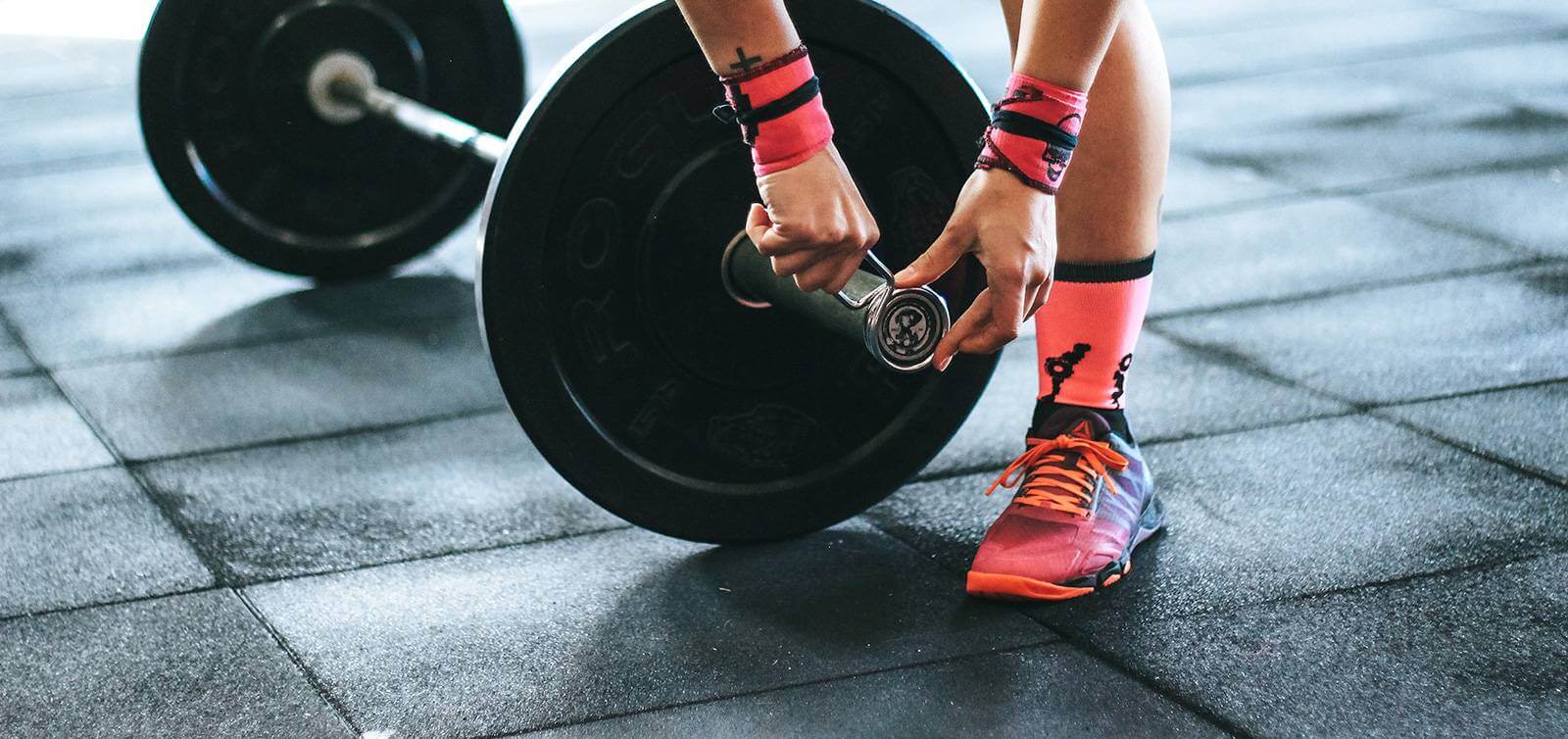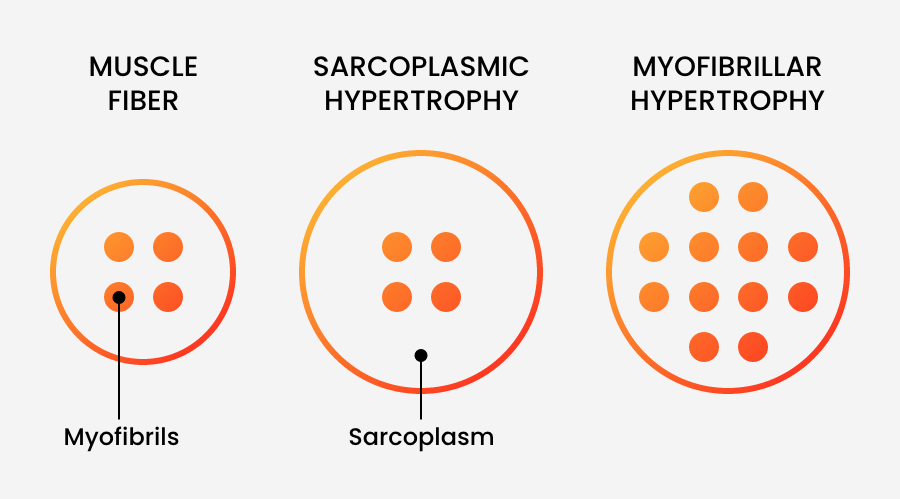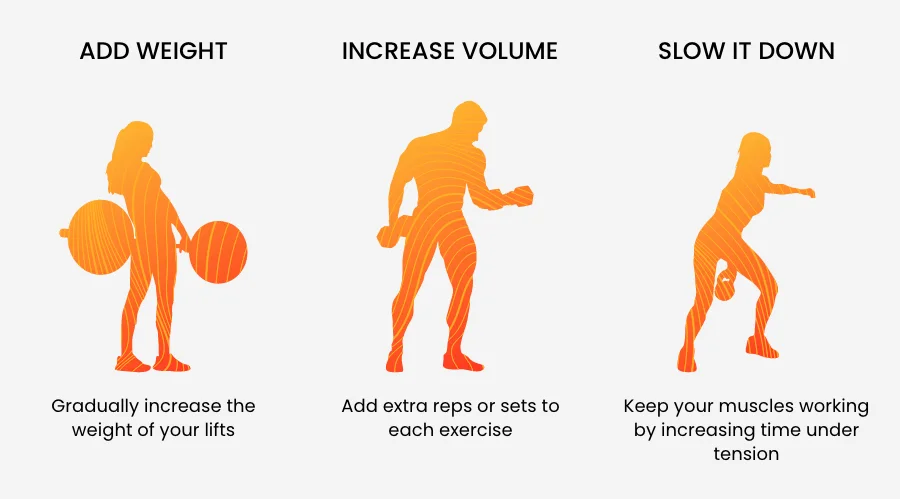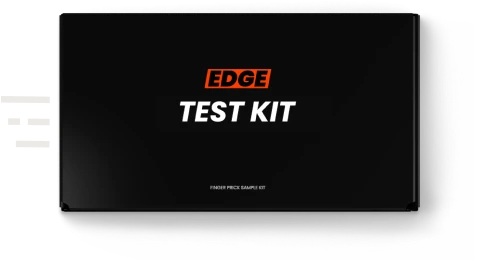
Strength
How to Build and Improve Muscle Mass
With the right mindset and approach, anyone can build muscle, gain strength and improve their physique. But what are the most effective strategies for muscle building? And just how much protein do you really need to eat each day?
1 min read
Published on
April 11, 2019
Written by
EDGE
Share this article
UNDERSTANDING HYPERTROPHY
The process of building muscle involves a physiological reaction called hypertrophy, which is simply the enlargement of muscle fibres. Weight training causes micro-tears within the muscle fibres, which the body heals by increasing the volume and density of the myofibrils, causing your muscles to grow in size and strength. This is why weight training is the cornerstone of any successful muscle-building routine.

Hypertrophy can occur in two ways: sarcoplasmic hypertrophy and myofibrillar hypertrophy.
Sarcoplasmic hypertrophy involves an increase in the volume of fluid within the muscle cell, which is made up of ATP, glycogen, creatine phosphate and water.
Myofibrillar hypertrophy involves an increase in the number of contractile units within the muscle cell. Although both sarcoplasmic and myofibrillar hypertrophy are important for muscle growth, myofibrillar hypertrophy increases the performance of the muscle.
In addition to weight training, there are several other factors that can influence hypertrophy. One important factor is nutrition. In order to build muscle, your body needs a sufficient amount of protein, as well as other nutrients like carbohydrates and fats. Without these nutrients, your body won’t have the raw materials it needs to repair and grow muscle tissue.
HOW MUCH SHOULD YOU EAT FOR MUSCLE GROWTH?
A crucial step to building muscle is creating a calorie surplus[1]. This means consuming more calories than you burn. Muscle growth requires energy, and if you don’t eat enough, your body will not be able to build new muscle mass. Research shows you should aim for a calorie surplus of 350-500 per day. That means, if your maintenance calories are 2,000 per day, you should eat between 2,350 and 2,500 calories per day for muscle growth.
Not all calories are created equal. While it’s important to consume a surplus of calories, you want to make sure those calories are coming from nutrient-dense foods. This means focusing on foods like lean meats, whole grains, fruits, and vegetables, rather than processed and junk foods.
HOW MUCH PROTEIN DO YOU NEED FOR MUSCLE GROWTH?
However, it’s not just calories you need to look at. You want to make sure you’re consuming enough protein to support muscle growth. A good rule of thumb is to eat between 1.4 and 2.0 grams of protein per kilo of bodyweight every day[2]. For example, a person weighing 70kgs would need 85 to 154 grams of protein per day.
One often overlooked aspect of muscle growth is hydration. Drinking enough water is essential for muscle recovery and growth, as it helps transport nutrients to your muscles and flushes out waste products. Aim for at least 8 glasses of water a day, and more if you are exercising intensely.
FOCUS ON PROGRESSIVE OVERLOAD
Progressive overload is a fundamental principle in weightlifting that refers to gradually increasing the stress placed on your muscles over time. It involves consistently challenging your muscles by gradually increasing the intensity, volume, or weight of your workouts. By doing so, you continually push your muscles beyond their comfort zone, forcing them to adapt and grow stronger.
There are several ways to implement progressive overload. Firstly, you can increase the weight you lift. This can be done by adding more weight plates to the barbell or using heavier dumbbells. However, it’s important to maintain form and focus on mind-muscle connection. Don’t increase the weight until you’re ready. A good way of knowing when to increase the weight is to track your reps. If you’re managing more reps or getting to your rep goal without feeling as tired, you can try increasing the weight. Add weight slowly, increasing by 5-10% each time.
Secondly, you can increase the number of reps or sets you perform for a given exercise. For instance, if you were previously doing 8 reps for 3 sets, try adding another set or doing 10 reps instead.
You can also try to increase the time under tension by slowing down the negative (eccentric) part of each rep. This forces your muscles to work harder for longer.

When you consistently challenge your muscles with increased difficulty (weight, reps, time under tension), they respond by increasing in size and strength to better handle the stress. By progressively overloading your muscles, you promote the development of lean muscle mass, improved strength, and enhanced muscular endurance. Remember to increase the workload gradually to avoid injuries and ensure proper recovery.
HOW MANY REPS FOR MUSCLE GROWTH?
Research has found that hypertrophy can be achieved with rep ranges between 6 and 40. However, most bodybuilders aim for 8 to 12 reps per set for efficiency. One study had 2 groups of men doing 2 different rep ranges. One group did 3 sets of 10 reps, with 90 seconds rest between each set, while the other group did 7 sets of 3 reps, with 3 minutes rest between each set. There were no observed differences in muscle growth, but the time taken to complete the workouts were drastically different, with the 3×10 group finishing much sooner[3].
You want to be as efficient as possible when focusing on muscle growth, so it’s best to aim for 3-5 sets of 8-12 reps for hypertrophy and muscle growth. You also don’t want to be resting too long between each set, either. Aim for 1-2 minutes of rest between sets, with slightly longer for heavy compound lifts.
ESTABLISHING A WORKOUT ROUTINE
As well as hypertrophy, it’s important to establish a consistent workout routine. This should include both weight training exercises and cardio. Your weight training routine should target each major muscle group (chest, shoulders, arms, back and legs) at least once a week.
How you train and the routine you pick will depend on your goals, time and personal preference. Some common weight lifting routines are:
PUSH, PULL, LEGS
Push, Pull, Legs (PPL) is a popular weightlifting routine that divides your workouts into three main categories: push exercises, pull exercises, and leg exercises. PPL is arguably the best weight lifting routine for muscle growth.
Push exercises primarily target the muscles involved in pushing movements, such as the chest, shoulders, and triceps. Examples include bench press, shoulder press, and triceps dips.
Pull exercises focus on pulling movements that engage the back, biceps, and rear shoulder muscles. Some common pull exercises are pull-ups, rows, and bicep curls.
Lastly, leg exercises concentrate on strengthening the lower body, including the quadriceps, hamstrings, glutes, and calves. Squats, leg press, and Romanian deadlifts (RDLs) are typical leg exercises.
By targeting different muscle groups on different days, PPL allows for proper recovery while maximising muscle stimulation. It also ensures that all major muscle groups receive adequate attention and development, as you’re able to work them up to twice per week (if you have enough time!).
An example of a PPL routine looks like:
-
Day 1: Push
-
Day 2: Pull
-
Day 3: Legs
-
Day 4: Rest
-
Repeat
UPPER BODY, LOWER BODY
If you don’t have time to hit the gym 3-6 times a week, you might opt for an upper body and lower body split. This involves combining push and pull movements into a single workout, with legs and core in another.
This type of training is great if you’re short on time, as you can target multiple muscle groups in a single session, combining two days into one. But, you might not get the same results as a PPL routine. This is because you are working more muscles in the same space of time, which limits the amount of hypertrophy you can achieve. You may also find you need more rest between sessions, meaning you can only go to the gym 2-4 times a week.
FULL BODY
A full body workout is a great way to get your muscles working, calories burning and heart pumping. However, much like the upper/lower split, you may struggle to properly work each muscle group in a single workout, and unlike PPL where muscle groups recover while others work, there is no downtime for full body workouts, meaning you’ll be able to do fewer sessions per week.
However, pairing full body workouts with other activities, such as running, swimming and cycling is a great way to stay fit and maintain muscle mass.
DO YOU NEED SUPPLEMENTS?
Supplements are an excellent way to supplement your diet, but it is important to remember that they are not a substitute for a healthy diet. A well-balanced diet can provide you with all the essential nutrients that your body needs to function correctly. However, supplements can help fill in the gaps and ensure that your body is getting all the nutrients it needs to thrive.
Protein powder is one of the most popular supplements used by athletes and fitness enthusiasts. It is an excellent way to increase your daily protein intake and can help support muscle growth and recovery. Whey protein powder is a common choice and is easily digestible. Vegan protein powders are also available for those who prefer plant-based options.
Other common bodybuilding supplements are;
-
Creatine: Creatine is one of the most studied supplements on the market and is shown to provide energy, increase lean muscle mass and improve strength[4].
-
Multivitamins: Multivitamins are another supplement that can be beneficial for overall health and wellbeing. They contain a variety of essential vitamins and minerals that your body needs to function correctly. While a well-balanced diet can provide you with most of the nutrients you need, a multivitamin can help fill in any gaps.
-
BCAA: Branch chain amino acids (BCAA) have been proven to help increase muscle growth, reduce soreness and fatigue, prevent muscle wasting, and support liver health[5]. However, BCAAs can be found in common foods such as eggs, meat and dairy products.
It is essential to remember that supplements are not a magic solution and should be used in conjunction with a healthy, protein rich diet and regular exercise. They can help support your fitness goals, but shouldn’t be the only source of protein and vitamins.
AVOIDING COMMON MUSCLE BUILDING MISTAKES
Building muscle is a goal that many people strive for, but unfortunately, not everyone achieves it. One of the biggest mistakes that people make when trying to build muscle is lifting too heavy, often referred to as ‘ego lifting’. It’s important you start with a weight you can manage to achieve hypertrophy and avoid injury. Focus on mind-muscle connection, and the concentric and eccentric motions of a lift. Once you’ve mastered the form and feel ready, then you can apply progressive overload to the exercise to achieve hypertrophy.
Another common mistake is not getting enough rest and recovery time. Many people think that the more they work out, the faster they’ll see results. However, muscle growth actually occurs during periods of rest, so it’s important to give your body time to recover between workouts. This means taking at least one or two rest days per week, and getting enough sleep each night.
In addition to challenging your muscles and getting enough rest, it’s also important to consume enough protein to support muscle growth. Many people make the mistake of not consuming enough protein, which can hinder their progress. Remember to consume 1.2 and 2.2 grams of protein per kilo of bodyweight every day, and make sure to include protein-rich foods in every meal.
Finally, it’s important to listen to your body to avoid injury. Lifting too heavy or without proper form can lead to serious injury, which can put you out of action for weeks, months or even permanently. If you’re unsure of how to use a piece of equipment or perform a certain lift, ask a personal trainer for help.
By avoiding these common mistakes and following a consistent training and nutrition plan, you can achieve your muscle-building goals and see the results you’ve been working towards.
REST AND RECOVERY FOR OPTIMAL MUSCLE GROWTH
While weight training is essential for muscle growth, rest is equally important. Your body repairs and grows muscle tissue during periods of rest. Without adequate rest, your muscles won’t have the opportunity to repair and grow. In fact, overtraining can lead to muscle breakdown and injury.
During periods of rest, your body releases hormones that promote muscle growth. These hormones include testosterone, growth hormone, and insulin-like growth factor. Getting enough sleep is essential for the release of these hormones.
In addition to sleep, there are other ways to promote rest and recovery. One of the most effective ways is through massage therapy. Massage helps to increase blood flow to the muscles, which promotes healing and growth. It also helps to reduce muscle tension and soreness, helping you to train at your best.
If you feel tired or sore, take a break from your workouts. Pushing through fatigue and pain can lead to injury and setbacks in your fitness journey.
COMBINING WEIGHT TRAINING WITH CARDIO
In order to achieve optimal muscle growth, it’s important to combine weight training with cardio exercise. Cardio helps you burn fat, improves cardiovascular health, and maintains your muscular endurance. Incorporating a mix of both types of exercises can help you achieve a well-rounded fitness routine.
Cardiovascular exercise is also important for your overall health and well-being. Cardio can help you maintain a healthy weight, reduce your risk of heart disease and stroke, and improve your mood and energy levels.
There are many different types of cardio exercises to choose from, including running, cycling and swimming. The key is to find an activity that you enjoy and that challenges you. Aim for at least 30 minutes of moderate-intensity cardio exercise most days of the week.
When it comes to combining weight training and cardio, there are a few different approaches you can take. One option is to do both types of exercise on the same day. For example, you could do a weight training session and finish it off with a 15-30 minute incline treadmill walk.
Another option is to alternate between weight training and cardio on different days. For example, you could do weight training on Monday, Wednesday, and Friday, and then do cardio on Tuesday, Thursday, and Saturday. This approach can be more manageable for some people, as it allows you to focus on one type of exercise at a time.
MONITORING YOUR PROGRESS FOR MAXIMUM RESULTS
Finally, to achieve the best possible results, it’s important to monitor your progress. This can be done by tracking changes in weight, body fat percentage, and muscle measurements, as well as optimising your health with regular blood testing.. Keeping a workout log can also help you stay on track and monitor progress over time. There are many free apps to allow you to build and track your workouts, helping you to manage progressive overload and keep a routine.
However, monitoring your progress is not just about keeping track of numbers. It’s also important to pay attention to how you feel and how your body is responding to your workouts. Are you feeling stronger? Are you able to lift heavier weights or do more reps? These are all signs of progress that should be celebrated.
Another way to monitor your progress is to take progress photos. These can be a great way to visually see the changes in your body over time. It’s important to take these photos in the same lighting and pose each time to get an accurate comparison.
Monitoring your progress can help you identify areas where you may need to make adjustments to your workout routine or nutrition plan. For example, if you are not seeing the results you want, you may need to increase the intensity or frequency of your workouts, or adjust your diet to ensure you are getting enough protein and other nutrients.
Blood test for
Weightlifters
Male & Female Tests
sports doctor review
Results in 2 working days
Flexible subscription
Medically Reviewed

This article has been reviewed by our medical expert
Our expert Dr Thom Phillips works in NHS general practice and has a decade of experience working in both male and female elite sport. He has a background in exercise physiology and has published research into fatigue biomarkers.
Get 10% off your first order
Want regular tips on how to make the most of your results? Join our newsletter and we'll give you 10% off your order!
